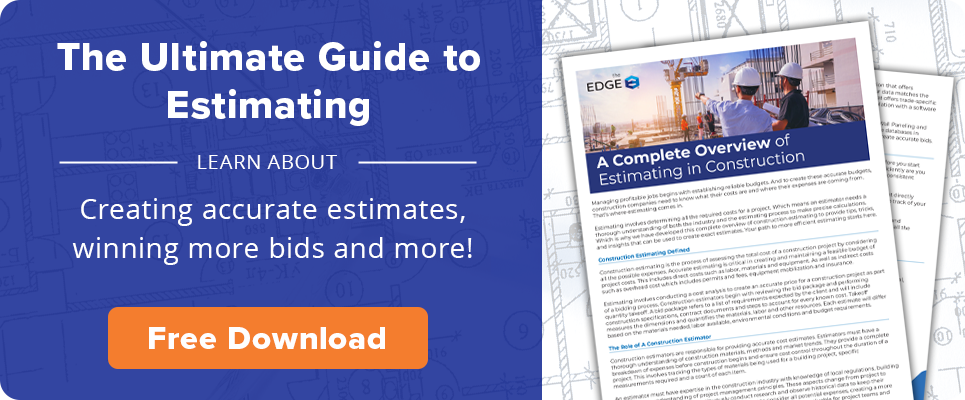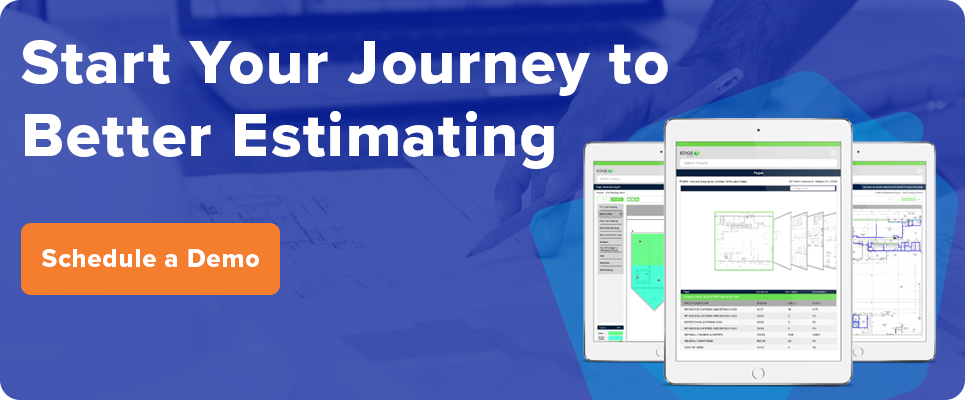
Managing profitable jobs begins with establishing reliable budgets. To create these accurate budgets, construction companies need to know what their costs are and where their expenses are coming from. That’s where construction estimating comes in.
Estimating in construction involves determining all the required costs for a project. Which means an estimator needs a thorough understanding of both the industry and the estimating process to make precise calculations. This is why we have developed this complete overview of construction estimating to provide tips, tricks and insights that can be used to create exact estimates. Your path to more efficient estimating starts here.

Construction Estimating Defined
Construction estimating is the process of assessing the total cost of a construction project by considering all the possible expenses. Accurate estimating is critical in creating and maintaining a feasible budget of project costs. This includes direct costs such as:
- Labor
- Materials
- Equipment
As well as indirect costs such as:
- Overhead costs, which include permits and fees
- Equipment mobilization
- Insurance
Estimating involves conducting a cost analysis to create an accurate price for a construction project as part of a bidding process.
Construction estimators begin with reviewing the bid package and performing quantity takeoff. A bid package refers to a list of requirements expected by the client and will include construction specifications, contract documents and steps to account for every known cost.
Takeoff measures the dimensions and quantifies the materials, labor, and other resources. After the takeoff process, estimators apply unit prices to calculate total costs for materials, labor and equipment. Each building estimate will differ based on the materials needed, labor available, environmental conditions, and budget requirements.
The Role of A Construction Estimator
Construction estimators are responsible for providing accurate cost estimates. Estimators must have a thorough understanding of construction materials, methods and market trends. They provide a complete breakdown of expenses before construction begins and ensure cost control throughout the duration of a project. This involves tracking the types of materials being used for a building project, specific measurements required and a count of each item.
An estimator must have expertise in the construction industry with knowledge of local regulations, building codes and an understanding of project management principles. These aspects change from project to project, so an estimator must continuously conduct research and observe historical data to keep their industry knowledge up to date. This allows estimators to consider all potential expenses, creating a more accurate construction estimate. Their cost-related insights are extremely valuable for project teams and clients by helping to save time and money.
Estimators work with most aspects of a project. Estimators will visit the construction site to begin conducting their project estimate. Before initial work has begun, they will meet with construction designers to review plans for the project and ensure no important details are missed. Estimators will often work with material and equipment vendors, labor unions and contractors as well to determine material prices and labor rates.
The Importance of Construction Estimates in the Bidding Process
An estimate directly impacts the bidding process. After the bid package is created, interested contractors will review and submit documentation about the project timeline and costs to the property owner.
Construction estimates are important because they add all projected costs of a project to the bid. With the cost information listed, a bid could make or break if the construction company is selected to take on the project.
The building cost estimate will be used by contractors to nail down a competitive bid, which represents the best quality at the most reasonable price. Since project estimates help to calculate what materials are needed, how much inventory is required and what manpower is expected when developers can make any necessary changes in project design so funding can be procured.
The Construction Estimating Process
The construction estimating process requires detailed analysis of every component, from materials and labor to equipment costs.
Picture the roof of a warehouse. How many nails did it take to fasten the shingles? How much tin coil flashing will it require?
Each one of these items costs something. The roof of any building is filled with details that need to be accounted for. This is all a part of the roofing estimating process.
The construction estimating process is an extremely detailed process and involves several steps:
- Review the Bid Package: The bid package contains a list of requirements expected by the client, including construction specifications, contract documents and steps to account for known costs. Reviewing the bid package entails: ensuring that all drawings and specifications are present, getting an overview of the project, evaluating structural requirements and identifying any nonstandard items.
- Conduct a Site Visit: It is important for estimators to visit the site to consider the conditions of it. Site conditions may influence the project costs if work needs to be done to amend the natural environment, access limitations and local regulations.
- Takeoff: Calculating the quantities of materials, labor and equipment required for the project is done to lay the groundwork for construction estimates. Quantity takeoff requires four key types of measurement: count, length, area and volume. Estimators will need to gain a comprehensive understanding of what needs to be quantified.
- Solicit Pricing: With the quantities determined, each item must then be assigned specific and accurate prices. Pricing everything accurately involves determining the cost of each material, any labor required and equipment items based on current market rates and supplier quotes.
- Evaluate Labor Requirements: An estimator will need to determine all the labor necessary for a project by specifying which roles are required for a project, how many hours will be necessary and how productive the crew is based on past projects. All the costs associated with workers, including wages, overtime, taxes, insurance, retirement, union dues or leave, must be budgeted into the cost estimate.
- Determine Bonds and Insurance Costs: Both bonds and insurance cost money for contractors and, therefore, must be covered. Typically, these items are annual costs; however, if a contractor needs to secure additional bonding capacity or insurance coverage, it will need to be factored into the project estimate.
- Calculate Overhead Costs: Overhead and indirect costs are typically not clearly laid out in the bid package. Any expense associated with operating a business can make or break the accuracy of an estimate. Estimators must establish a method for distributing overhead costs, direct costs and indirect costs to guarantee all expenses are included in the construction estimate.
- Account for Profit and Contingency: After calculating all the costs for a construction project, the estimator will adjust the total to account for profit and contingency. The profit refers to the fee contractors earn for the contract and a contingency refers to a portion, typically between 5-10% of the total project cost, that is set aside for overruns and waste.
As an estimator moves through this process, they will continuously update their initial construction estimates. Every building estimate is different, however the requirements defined within the process are similar across every trade.
Construction Takeoff
Construction takeoff directly impacts the accuracy of an estimate. Takeoff measures the dimensions and quantifies the materials, labor and other resources required to complete a construction project.
The takeoff process involves measuring quantities and calculating materials needed for each component of the project. It should be completed after the project scope is determined. The data gathered in a takeoff is then compiled to produce reliable pricing and construction costs.
During the takeoff process, estimators will carefully review architectural and engineering drawings, project specifications and any other relevant documentation to gain a comprehensive understanding.
Once the quantities are determined, the estimator can then begin estimating by applying unit prices or costs to each item to calculate the total material and labor costs. This includes items such as equipment hookups, wiring systems, piping components and more.
This is usually done by multiplying the quantities with appropriate unit rates. These rates may come from historical data, supplier quotes or industry-standard pricing references.
Use of Estimates During Construction
The role of construction estimates isn’t complete after the bid is won. Estimates serve as the foundation for a project budget, which means they’re used to monitor production throughout a project’s completion to ensure the budget is accurate.
The information provided by cost estimates allows contractors to make spending adjustments while a project is being completed so that timelines can be met. The data acquired by project estimates on the job can also help to improve budget expenses on similar projects going forward.
And, having access to the original construction estimate, change orders, drawings and takeoff documents during production helps project managers and foreman track inventory, scheduling and cost overruns.
(If you’re in need of easy construction jobsite project management, check out the EDGE On Site®! Our jobsite management app runs on an Apple iPad to bring your data to the field.)
Creating Construction Estimates
A construction estimate is a breakdown of expenses that communicates the assumed total cost of a construction project. It is designed to consider every potential cost in a construction project. Building estimates may vary in format and presentation depending on the specific requirements of the project and the preferences of the estimator.
Most likely, cost estimates will include the project information, including:
- Project name
- Location
- Client details
- Relevant dates
Construction estimates will feature an itemized cost breakdown that lists each component separately, accompanied by a description, quantity, unit cost and total cost for each item. This complete list will account for every possible cost a project could require.
Items Included in Construction Estimates
Included in building estimates are a variety of different costs that contribute to the overall budget of a project. These costs will be analyzed over a period of time before the bid can be submitted, throughout the duration of the project and again at the completion of the project. The numbers will change but typically always include:
- Project Scope: Defining the project scope helps to determine the goals, constraints, tasks and deliverables of a project. It involves reviewing all the project plans, drawings and specifications. Omitting scope items can be troublesome because a project scope helps to identify the overall requirements for a project.
- Takeoff Calculations: The calculated takeoff should be included next. Because takeoffs lay the groundwork for construction estimates, if they are incomplete or incorrect, it can result in an inaccurate determination of labor and equipment needs. Takeoff should always be completed after the project scope is determined to help avoid this.
- Supplier and Vendor Pricing: Once each item is assigned specific prices to each item, estimators can determine the cost of each aspect of the project. This is where accuracy will be the most crucial factor.
- Subcontractor Fees: This is dependent on certain projects, but if there are aspects of a project the general contractor can’t perform, they will hire a subcontractor. An estimator may need to solicit quotes from subcontractors to determine the cost of specifics within the project, as they provide valuable insights into project costs and help identify potential cost savings.
- Contingency: Perhaps one of the most crucial parts of cost estimates is contingency. This means calculating a portion of the budget to be set aside for unexpected costs or possible changes in the project scope. Calculating contingency will help keep the project on schedule and on budget.
- Final Estimate: Determining the final construction estimate is done by taking the sum of all the costs and providing a detailed breakdown. This breakdown should include a list of materials, labor rates and any additional expenses so that the project can be evaluated and reviewed easily.
At the completion of building estimates, the estimator should review the document and check their work. This means reviewing the project estimate to ensure accuracy and completeness. The construction estimator should also consider reviewing the project scope again to ensure that all requirements have been accounted for and that the construction estimate is within budget. Each aspect of the cost estimate helps to detail what will be expected of the contractor.
The Different Types of Construction Estimates
When referring to estimating, most contractors are referring to a bid estimate. However, estimators don’t only prepare construction estimates for the bidding process. Different types of building estimates serve different purposes in the project lifecycle.
The American Society of Professional Estimators (ASPE) has developed a five-tier system for classifying and building construction estimates. This system provides a standardized framework for categorizing cost estimates based on their level of detail and accuracy. The five tiers, also known as Classes, are:
Class #1:
Known as a Conceptual Estimate or Order of Magnitude Estimate, this type of construction estimate is often prepared during the early stages of a project to provide a rough cost assessment. Because it is typically based on experience or historical data, it relies on limited project information and lacks detailed design or engineering documents. These are based on other high-level assumptions, such as square footage, prior circumstances or similar projects. However, this method helps stakeholders evaluate the feasibility of a project, make early budget decisions or seek financing.
Class #2:
Known as a Preliminary Estimate or Schematic Design Estimate, this type of building estimate is developed during the schematic design phase to provide a more refined cost estimate. This will utilize schematic design documents, basic drawings and conceptual details to provide an itemized cost breakdown. Based on key building systems or components, this type of estimating assists in making design decisions, evaluating design alternatives and securing project approvals.
Class #3:
Known as a Detailed Estimate or Design Development Estimate, this type of construction estimate is developed during the design development phase to establish a comprehensive cost estimate and becomes the basis of the budget. This will rely on detailed design development documents, specifications and material requirements by providing a detailed breakdown of costs by the construction division, including labor, materials and equipment. This type of project estimate helps refine the design, assess the cost impacts of design changes and assist in value engineering exercises.
Class #4:
Known as a Construction Estimate or Bid Estimate, this type of cost estimate is prepared during the construction document phase to produce a reliable cost estimate for bidding purposes. It is often based on complete and detailed construction drawings, specifications and other contract documents to provide a comprehensive breakdown of costs for each construction activity or trade. This helps to form the basis for bid submissions, subcontractor selection and contract negotiations.
Class #5:
Known as a Control Estimate or Final Estimate, this type of construction estimate is developed as a final estimate during the project execution phase. This is the most reliable figure and can be used to control and manage costs. It will most likely be based on final design, engineering and procurement information to provide a detailed breakdown of costs for all project components and activities. This type of building estimate will guide project management, cost control, change order management and financial reporting.
The ASPE’s five-tier system helps stakeholders understand the level of detail, accuracy and purpose of different construction estimates at various stages of a project. This classification assists in effectively managing costs, making informed decisions and aligning expectations throughout the project lifecycle.
The Importance of Accuracy in Construction Estimating
Since every construction project is unique, cost estimates must be carried out individually for each project. The accuracy of construction estimates is essential to ensure that the project can be completed within budget and on time.
If building estimates are too low, the project may run out of funding before completion. This can lead to delays and cost overruns, among other problems. Also, if project estimates are too high, the project runs the risk of being deemed unfeasible and, therefore, may not be selected.
Tips for an Estimator
Successful bids need accurate construction estimates. To create accurate cost estimates, estimators need to mitigate risks and inaccuracies as often as possible. Here are a few tips to remember when conducting building estimates:
Know the Scope
One of the most common mistakes in construction estimating is overlooking the project scope. Items commonly missed include inspection fees, change orders and changing unit costs of supplies and materials. These items help to ensure that all the project requirements are identified and nothing is missed during the estimating process. This can also help to avoid misunderstandings and conflicts that could arise later in the project.
Remember Site Conditions
Failure to consider site conditions, such as the natural environment around the site or access limitations, can result in inaccurate construction estimates. Every jobsite is different and unknown site conditions can cause unexpected and costly issues when construction gets underway.
Always Have Contingency
Complete a risk assessment. Estimators should always find ways to consider alternative solutions that can reduce costs without compromising the project’s quality or functionality. Having a backup plan is very important for analyzing cost-saving opportunities and time-efficient options throughout the estimating process.
Remembering these tips can help to provide more accurate construction estimates. And to make sure you are producing the best work you possibly can, consider using an estimating software.
Construction Estimating Software
Construction estimating software streamlines the takeoff process and improves accuracy through automated calculations. This software allows estimators to digitally measure and calculate quantities, automate the pricing process and generate detailed reports and construction estimates. These tools can streamline the estimation process and improve accuracy and efficiency.
Estimating software helps to:
- Promote the accuracy and efficiency of a construction project.
- Automate measurement calculations and provide digital takeoff.
- Reduce errors and inaccuracies.
- Determine a comprehensive cost estimation.
- Create detailed reports and data analysis to see the overall picture more clearly.
- Offer cost-saving opportunities to help budget projects efficiently.
- Quickly deliver results to meet deadlines.
- Allows project managers to communicate any issues with team members.
- Adapt to the changes in a project.
- Allow estimators to easily update quantities and costs as the project evolves.
When looking for estimating software, it will be in your best interest to find a solution that offers trad-specific features. Utilizing a software specific to your trade helps to ensure your data matches the project requirements. When looking for estimating software, consider a solution that offers trade-specific features. Picture a warehouse roof. If you are a roofer trying to measure tapered insulation with an estimating software designed for painters, that would make it difficult to calculate.
If you work in the Acoustical, Drywall, EIFS, Fireproofing, Flooring, Painting, Roofing, Wall Paneling and Waterproofing trades, consider Estimating Edge. We offer trade-specific, customizable databases in construction estimating and digital takeoff that have helped thousands of estimators create accurate bids.
Take Your Construction Estimates To The Next Level With Construction Estimating Software
To win more profitable jobs, it’s essential to create more accurate construction estimates. However, before you start adjusting your estimating process, take the time to analyze your current system.
How efficiently are you completing cost estimates? Historically, how precise are your cost projections? Where are the consistent inaccuracies?
By providing some answers to these questions, you’ll have a place to start.

If you choose to purchase new software or upgrade to different construction estimating software, find a solution that directly solves the problems you’ve identified. As you implement new ways to estimate, always keep track of your estimating success rate.
Overall, whether it’s understanding the estimating process, knowing the common mistakes and implementing solutions to mitigate errors or finding a different estimation method, knowing all the different aspects of estimating is important for any type of construction project.
Creating accurate construction estimates remains the foundation of successful project management and profitable contracting.






